- Rule, Britannia, no more?
- Unpopular Opinions: US Quadball Cup 2023
- Proven Contenders: University of Virginia
- Proven Contenders: Rutgers University
- Proven Contenders: University of Michigan
- Proven Contenders: Creighton University
- Different Perspectives: A Look Inside USA Ultimate
- Antwerp QC, Much of Belgian Core, Leaves Competitive Quidditch
Round Table: Correspondents Discuss Preseason Thoughts
- By Kevin Oelze
- Updated: August 17, 2014
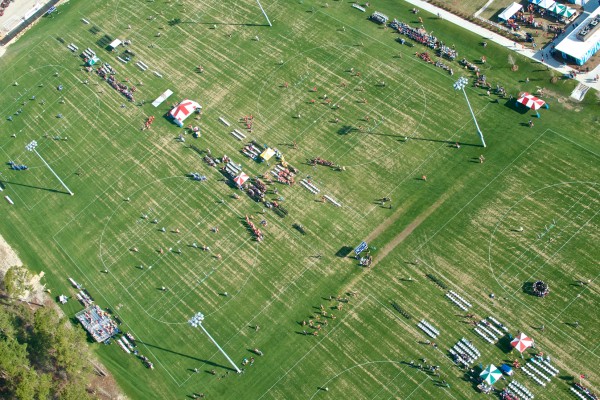
Credit: Michael E. Mason
With the season approaching, we decided to gather up The Eighth Man writers and get their opinions on a few of the central issues USQ has faced this summer, as well as their early thoughts on the coming season.
1. Sitting here now, what are your current thoughts on the transition from the IQA to the USQ?
We Breathe Quidditch (WBQ): I’m relatively pleased by the transition, to be pretty honest. There are a lot of bumps and question marks up in the air, and I know many people were angry at how slow footage of games are being released (me included), but that has always been a problem. And while yes, the current USQ is understaffed, the only major problem to come out of the split so far was the RDT/IRDP.
Mollie Lensing: It was not well orchestrated and the transition feels very unsettled, as in, there appears to be more issues now than there were before. Don’t get me wrong, I think this transition was necessary, but I don’t think all the stakeholders were properly involved during the decision phase of how this transition was going to take place.
Luke Changet: There are a lot of issues within USQ, as there have always been, but the “transition” from the IQA to USQ went about as smoothly as it could have. There weren’t any major staff changes during the changeover, it was really just a change in name. It doesn’t mean much within the USA, but it means everything for quidditch abroad.
Ethan Sturm: I think in some ways it’s gone smoothly enough, and in other ways it’s gone horrendously. On the upside, the departments that were running well before the split are largely still running well. We have a new rulebook. We have new gameplay policies. We have a new membership plan. The downside is largely problems not even connected to the split. Simply put, the USQ has forgotten the value of its volunteers.
2. How do you feel about the Lone Star Quidditch Club recruiting style, as Kody Marshall explained it, “Just open up tryouts to anyone and select the best players?”
Tad Walters: I like it a lot, but I don’t think now is the time to have that mentality. In a few years, when the loss of a top player will not affect a team that much, I would have no qualms with Lone Star’s recruiting strategy. As quidditch stands now, some of these collegiate teams have only a handful of good players, many of which are teachers and role models for the rest of the team. I’m worried what the loss of some of these players to teams like Lone Star will do to the college teams in the long run.
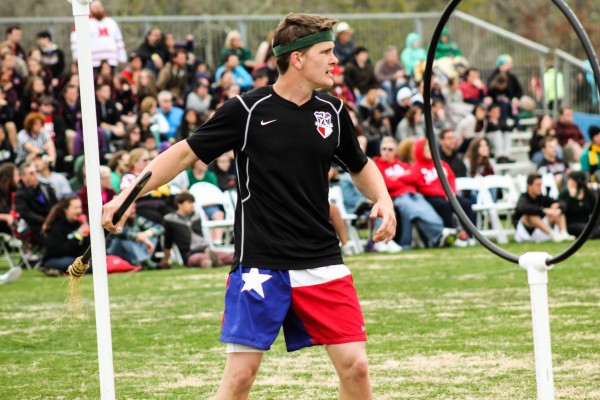
Credit: Nicole Harrig
Sturm: I mean, it seems fine. I have a serious problem with the “coaxing players off other teams” style of community team recruiting, but outside of that, they should do whatever works for them. I don’t know if the whole University of Texas San Antonio fiasco last season was within the scope of this recruiting style, but let’s just hope we don’t see a repeat of whatever that was.
Sean Pagoada: I have no qualms about it. It has been working out wonderfully for them, and they should go even further this year with the plethora of new talent they’ll be receiving.
Lensing: I think it’s fine because this is the future of what semi-pro quidditch will be. The players interested in playing at a higher level can try out for one of these teams if that aligns with their competitive goals, or they can choose to play collegiate and develop their skills.
WBQ: That’s how community teams should be recruiting. You’re going to end up poaching some players from teams, but if you do, that’s completely the choice of the player. Bottom line, there’s only so many players a single community team can poach with this method, and there are only 21 slots on a roster.
Kevin Oelze: It’s a great way to build a great program. At the same time, I feel like it’s going to force a greatly expedited transition from a one-tier to a two-tier community and college league.
3. Which non-Southwest teams have the best chances at a championship title?
WBQ: University of Kansas and University of Maryland. It’s funny because these teams are the teams that are most likely to be wiped out by a random team before they even get far in bracket play. Yet it was Maryland that gave University of Texas its toughest game at World Cup VII. It was Kansas that outplayed Texas A&M University and held Lone Star within snitch range, while Ohio State University got decimated by the Lost Boys.
Kansas needs to improve their beater-on-snitch game. Kansas’s much praised seeker Keir Rudolph lost snitch grabs to Bowling Green University and A&M. Bludger control was no excuse as Kansas held bludger control for 85% of both of these games. On the opposite side, Kansas put both bludgers on the Lone Star seeker, allowing Lone Star to score repeatedly against a zero-bludger Kansas defense.
Maryland needs to do a better job containing opposing offenses. They can get bludger control, and have done so against both Texas and Emerson College, but their bludger control is ineffective. It doesn’t change the rate of scoring by much at all. Furthermore, they need to find out how to score consistently and pull out of snitch range.
Pagoada: Going off of last season it seems Maryland should be the clear favorite.
Lensing: Maryland and QC Boston: the Massacre. For QCB, they had a disappointing World Cup and knowing how competitive a lot of the players on that team are, I predict they will be coming into this season hungry to really establish themselves as an elite community super team moving forward. Plus they will have a nice pool of elite, Boston-area graduates to potentially add to the roster, which will provide them some much needed depth of experience.
Another team I think might fly under the radar all season but could easily produce some upsets at World Cup this year and potentially give the Southwest teams a run for their money is Florida’s Finest. My biggest question mark for them is whether or not they will gain experienced players of the same magnitude that Lone Star, QCB and some of the Western community teams will this season.
Changet: I think Ohio State has a real shot at another, deeper, run. They were a closed hand away from the Final Four, and they lost exactly zero players from that squad. They’re easily the early favorites in the Midwest, and with another year of growth and recruiting, Ohio State could be scary. Another one is Maryland.
Then you have to look at community teams. The LA Gambits, if they can round out their roster, look intimidating. Whatever is left of the Lost Boys is in the same boat. The Warriors have a large talent pool to take from, and QC Boston seems staged for a breakthrough after making moves to secure their beating problem. Blue Mountain Quidditch Club (BMQC) will be talked about a lot, but I don’t see us as World Cup contenders yet. We’re still a first-year, spread-out community team with some depth issues.
Walters: Maryland! After last year’s intense game with Texas, I could see Maryland making a deep run, especially if luck is on their side in brackets.
Oelze: I hate to have nothing original, but Maryland. I don’t see anyone else remotely close. Maybe QCB if they can pull in the recruits, if I have to give another one.
Ethan Sturm: Maryland, Maryland, Maryland and…Maryland.
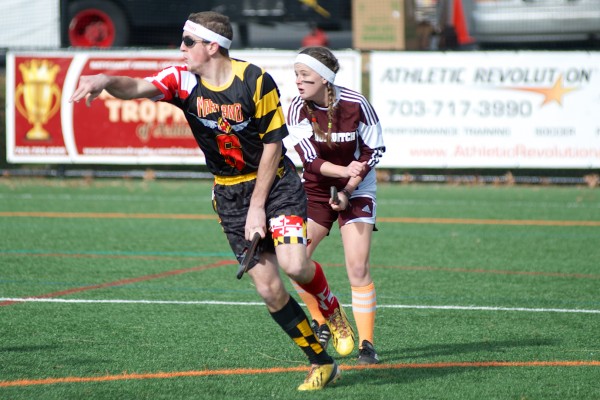
Credit: Michael E. Mason
4. Will community teams see natural balance as talent and personalities clash and “super teams” split into smaller teams?
Walters: I could definitely see some drama unfolding from egos on some of the big community teams. I can also see splits happening from teams that have so much interest, they just have to split into two teams. But I think most of the established teams will be fine and this is more a question of the upcoming community teams.
Sturm: I honestly don’t believe that is going to be the case. What happened last year was a travesty, but it was a very predictable one. The spark plugs for internal team issues from Lost Boys to the NYDC Capitalists to Massacre could have been identified even before the season starts. I think such problems will be excised by this season, and the elite community teams will continue to rise in ability, while the problem child castoffs try to create more community teams that have even more problems.
Pagoada: I don’t think this is true for all community teams. Take Lone Star for instance, every player that makes that team will do what’s best for the team in order to win the title and I have full confidence of that. As for other teams, yes this will come up as a problem, but school teams have their own politics and “quidditch drama” that can also get in the way of a team’s true potential. All in all, the top community teams will rise to the occasion and progress even further this year.
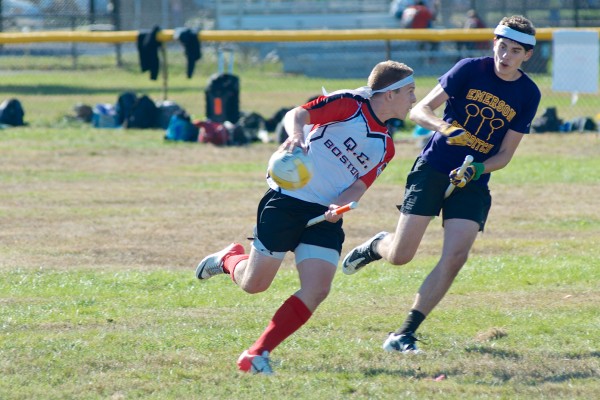
Credit: Michael E. Mason
Lensing: I think we are on the cusp of a semi-pro league of quidditch—total development is years out, but we could have separate championships very soon. So while in the short term there may be more splits among the big teams, as previous college stars graduate and can’t figure out how to work on a team where they aren’t necessarily the best player, in the long term, more experienced quidditch players are graduating every year that plan to continue playing. This creates a larger pool of players available to join these teams. This pool will ultimately lead to more teams being developed across regions to meet the players’ desires to continue playing quidditch, but it will also lead to the well-established teams having the first pick out of that talent pool, which will continue to improve the depth of their rosters. Over time, this imbalance will work itself out, but for the next couple years I imagine the same already established community teams will dominate the league until practice frequency and geography play a bigger role in a player’s decision to join a specific team.
Changet: Yes, I do think community teams will, in the end, become very balanced as more and more players graduate and need a place to play. The split ups are inevitable, as more teams are bound to form. As we’ve seen, the talent flocks to one location at first (Lost Boys, Lone Star, NYDC), but eventually there are too many great players looking for a team and splits need to happen. One day there will be community teams in every major city, and it is likely that a separate league for only community teams will be created. This league would function somewhat similarly to professional sports leagues, and the talent levels would reflect that. This is not something that is imminent right now, but I do believe a separate league will exist within the next five years.
5. Pick a way-too-early winner for each region and champion.
WBQ: Boston University, Maryland, University of Miami, Lone Star, Ohio State, who knows in the West or Northwest? Texas as the champion.
Sturm: Massacre, Ohio State, Maryland, Florida’s Finest, Lone Star, the West and NW is wide open. Lone Star as the champion.
Walters: Texas, Miami, Maryland, the Warriors, BMQC, Silicon Valley Skrewts, the NW is wide open. Texas takes its third championship in a row.
Pagoada: Lone Star, Lost Boys, Bowling Green, Massacre, Florida’s Finest, Maryland, the NW is wide open. No champion given.
Lensing: Lone Star, Florida’s Finest, Lost Boys, Ohio State, Massacre, Maryland, the NW is wide open. Lone Star as the champion.
Changet: Massacre, Maryland, Miami, Ohio State, Lone Star, Skrewts, the NW is wide open. Texas repeats as champions.
Oelze: Massacre, Maryland, Florida’s Finest, Ohio State, Lost Boys, Lone Star, Boise State University. Lone Star becomes the first community team champion.
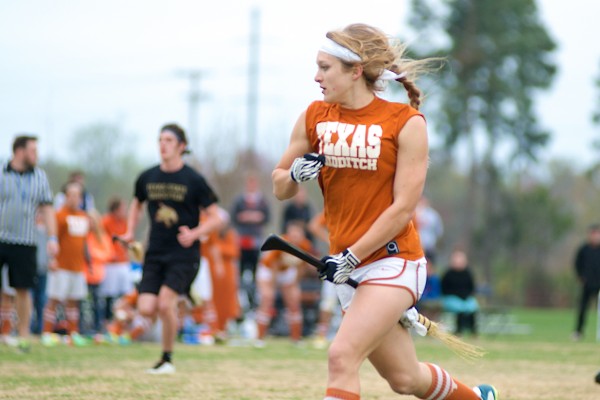
Credit: Michael E. Mason
About Kevin Oelze
Kevin is the co-founder and technical director of The Eighth Man. In his off time, he masquerades as a software engineer, and actively participates in karaoke duels. Despite the rules calling for Jason Mraz-only duels, his go-to song is ""Brighter than Sunshine"" by Aqualung.



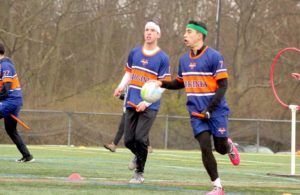
One Comment